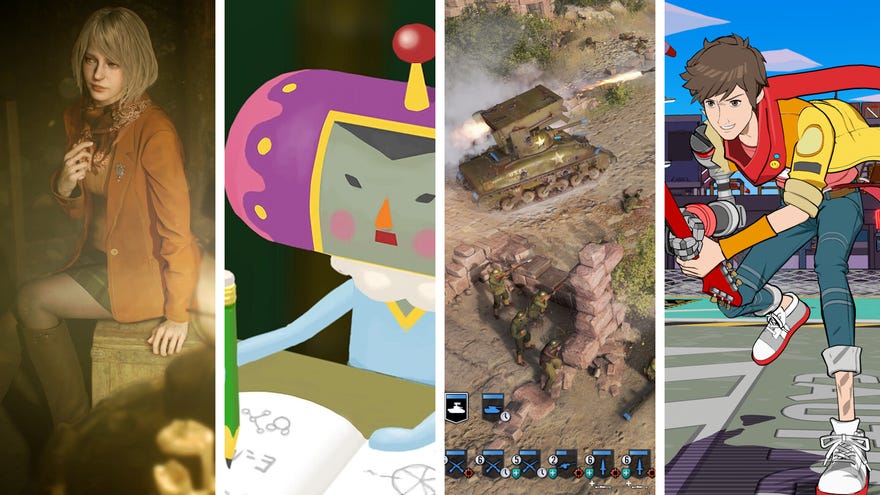Our 22 favourite games of 2023 so far
Come and see the current contenders for this year's Advent Calendar
Don't look now, but we're almost halfway through 2023. How is that even possible? I hear you cry. Well, I'm not entirely sure either. The last time I checked it was freezing cold outside and the sun went down at 3pm, but here we are with long, sunlit evenings and that sticky sheen of an early, muggy summer. Or at least it's been quite clammy in the RPS Treehouse this month, as we've all been sweating over our favourite games of the year so far.
2023 has had a pretty great first six months, I reckon. Or at least a great first half if you're into shiny remakes of games that came out ten to twenty years ago. Those folks have had a brilliant time, all things considered, as have non-PC folks with the likes of a new top-tier Zelda game to enjoy and another honking great Final Fantasy game in the space of as many months (the latter of which will eventually come to PC as well, although alas we don't know when just yet).
But even without Final Fantasy 16 on the books for us this year, if the rest of our picks on this list are anything to go by (plus the likes of Baldur's Gate 3, Starfield and loads more of our hotly anticipated list yet to come), I wouldn't be surprised if 2023 ended up being a year for the ages. There are a lot of great video games out there, so read on below to find out which ones have impressed us the most so far.
Babbdi

Alice0: One of the best things a game can do is drop me into a weird place with little explanation, let me explore freely as I try to figure out what this place is and what even the game is, then wrap up inside an hour. And if it's free too? What a joy.
First-person explorer Babbdi is set in a grim Brutalist city you want to leave. All you need do is get a train ticket and catch the train. This turns out to be a little more involved than expected, but not much more. You can complete Babbdi in under two minutes without using glitches. The rest of my hour went to exploring the city, discovering strange sights, meeting people going about their daily lives or dancing in the sewer or lounging in a fountain, collecting secret objects, and mucking about with gadgets. Babbdi offers you everything from motorbikes to trumpets, then turns you loose to see what you can do with them. The freedom to explore with unusual movement tools can feel like you're breaking the game—a good feeling—but no, Babbdi largely inuldges foolishness and even rewards it with new toys. Then when you're done larking about, the end is mere minutes away, the game's pace always controlled by your own.
I never did find out what the trumpet is for, beyond delighting me. Isn't that enough?
A Space For The Unbound
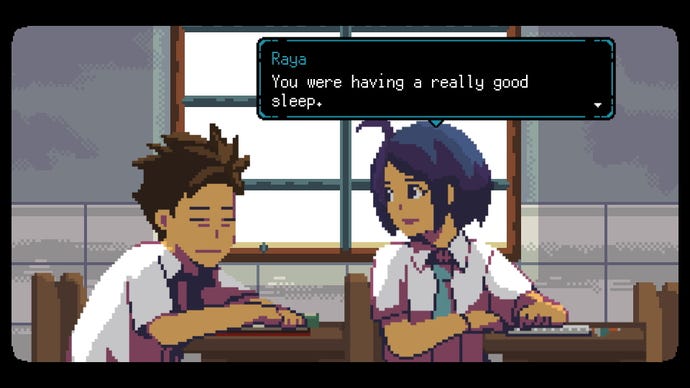
Katharine: I'd been looking forward to A Space For The Unbound for the longest time, and developers Mojiken did not disappoint. On the surface, it's a supernatural romance drama with magical, time-travelling teens at the heart of it, but look closer and this is a smart and moving story about grief, loneliness and the power of human connection. It also has lots and lots of cats (that you can pet and individually name), which, you know, obviously makes it excellent too.
But more seriously, A Space For The Unbound's greatest triumph is how it keeps you guessing right until the last moment. Even with the ability to 'space dive' into people's minds to solve their innermost problems, this is a game that keeps its cards very close to its chest. It does a brilliant job of keeping you in suspense, and its plot escalates with pleasingly anime levels of grandeur until its climatic and emotional final act. It was an absolutely cracking way to start the year, and I don't think any other game from the last six months has even come close to making me feel the same kind of happy-sad as I did playing this.
Hi-Fi Rush
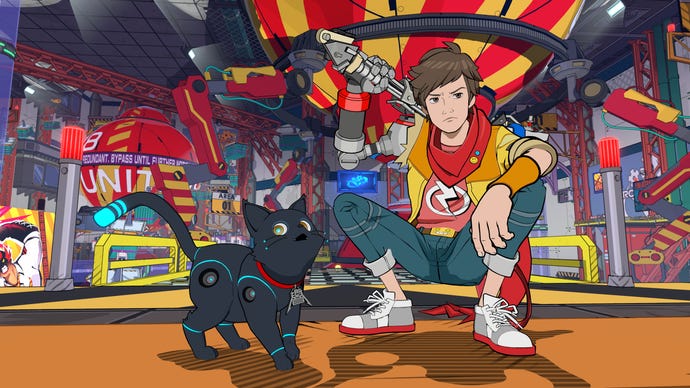
James: Good rhythm action games are like good comedy bands: they work because they come from a sincere appreciation, and respect, for music. Hi-Fi Rush has both, and moreover, understands the power of music, of how it can make your foot tap and your neck tingle and your blood shoot up your body like every Bonfire Night firework being let off at once. Sheesh, Hi-Fi Rush, why don’t you just marry music if you love it so much.
It's an infectious love, of course. Landing combos builds on the backing track with layers of cheers and guitar licks, turning each fight into a joyous jam session, and the latter half contains both of my top two favourite moments in any game this year. In both cases, that’s thanks to their incalculably perfect choices of backing song (The Prodigy’s Invaders Must Die and The Joy Formidable’s Whirring, fyi) and the overwhelming sense of impetus that only a good tune can produce.
Dead Space
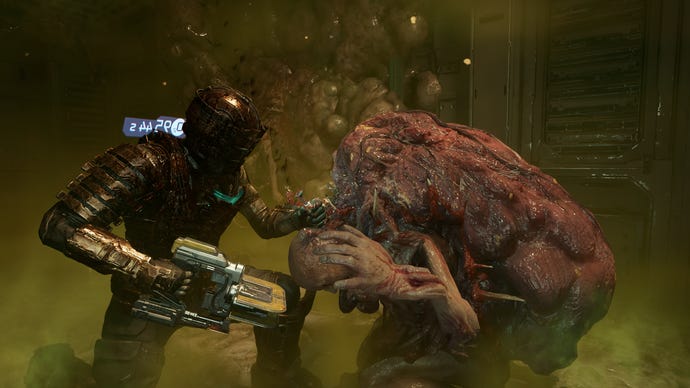
James: There are enough dubiously necessary remasters out there that any second attempt at a game is met with as much suspicion as interest. If only they could all be like the Dead Space remake, which takes an already prime example of good action-horror, lovingly polishes up the parts that worked, and either chucks or replaces the ones that didn’t.
The result is, frankly, a better game. That’s not a spiteful response to nostalgic anti-remake NIMBYism, it just is. Nu-Dead Space’s USG Ishimura is more atmospheric, its Necromorphs are ickier, and even its non-undead characters are more interesting, fleshed-out, and proactive. Also, it doesn’t need a billion mods to run on PC.
Season: A Letter To The Future
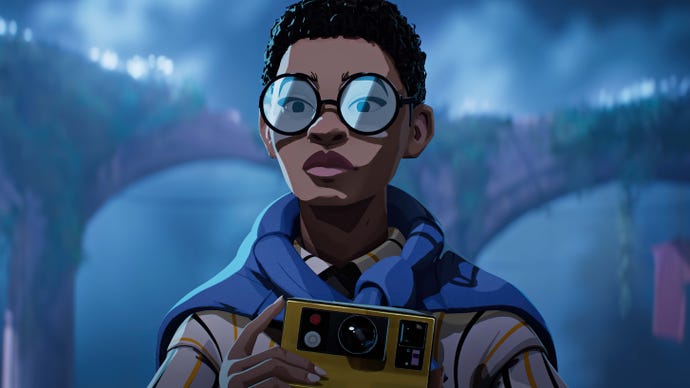

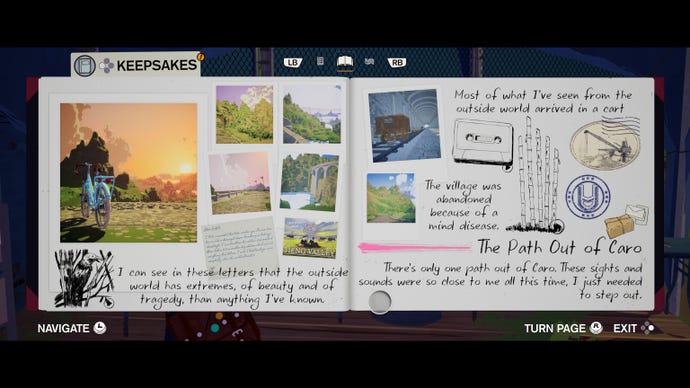

Katharine: Season is one of those games I wanted to wring every last drop out of before pushing on to the end - which is fitting, really, given it's about a young woman who's made it their purpose in life to chronicle the dying moments of their current era before some nebulous event wipes it from the annals of history and conscious human memory. It's a strange, melancholy sort of game, but one that really lets you relish in the details as you assemble your observations via sound, sight and the written word. You can take pictures of whatever you please, record whatever sounds you think are interesting, and compose your thoughts about the landscape, objects and people you meet along your journey.
But most places are only afforded a double page spread in your notebook, meaning you'll need to pick carefully what you want to preserve - not that anyone's judging you, mind. They won't remember. But as someone who will remember, thanks to the special pendant your mother made for you before you set off, the sense of responsibility in choosing what to commit to paper felt weight and meaningful. It's the kind of game that would make a fascinating show and tell between different scrapbooks. What things did you choose to save? And what does that say about you, as a person? I love it when a game asks these questions, and I'm still sad it had to come to an end.
Wild Hearts

Ollie: Wild Hearts, as with many big games released in the first half of 2023, was a bit of a hot mess at launch. Some pretty gnarly performance issues forced a lot of people away from the game early on, but I still loved it from the beginning. It brought me right back to my early days playing Monster Hunter Freedom on the PSP for hundreds of hours, stomping on creatures ten times my size with ludicrously large swords and hammers.
Wild Hearts is more fun than any Monster Hunter game I've played, and that's thanks to the Karakuri - self-building gadgets and gizmos that you can place down mid-fight to give yourself an edge. Giant monster charging at you? Place down a stack of Crate Karakuri to spawn a wall and stop it in its tracks. Need to close the distance while the beast is stunned? Launch yourself forward with a Spring Karakuri. You can even combine various Karakuri in certain configurations to create temporary "Fusion Karakuri" like a chain trap, or a healing mist. It adds so much creativity to the art of battling creatures, and makes me feel so much more badass than I've ever felt in a Monster Hunter game.
Birth
.jpg?width=690&quality=80&format=jpg&auto=webp)
Rebecca: Birth is one of the most wholesome and chill indies I've ever played — not in spite of its vaguely grisly concept, but actually because of it. This short puzzle game — easily completed in a single sitting — tells the story of a character who has moved to a new city where they don't know anybody. So they set about making a friend. Literally. Everyone in this world, including our protagonist, is made up of vaguely animal carcass looking bits, and there are plenty of spare odds and ends knocking about. Enter a café or a neighbour's apartment and nudge around completing a few puzzles, and you'll be rewarded with another body part that goes towards making your companion.
The story is told wordlessly through your interactions with the environment, and yet I've rarely had a clearer sense of the message of a game in my life: "It can be hard making new friends as an adult, but even in a world where everyone seems sort-of scary, most people are really kind." There's plenty more to be drawn out, but I highly recommend you check this one out and mull it over for yourself.
Company Of Heroes 3
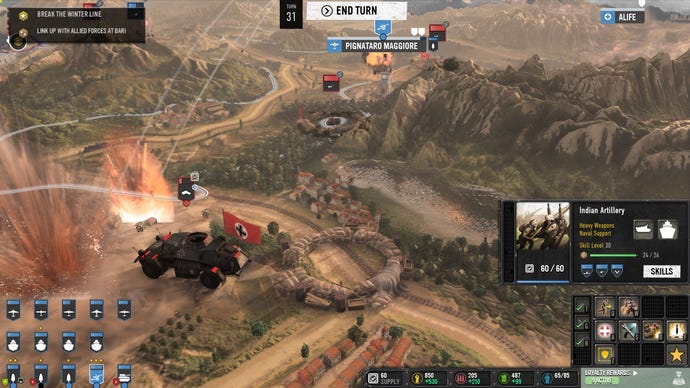
Katharine: A rip-roaring return to form for Company Of Heroes, and arguably the most fun I've had with a real-time strategy game since, well, a long time. While I haven't dipped into much of the multiplayer since launch, its pair of campaigns still linger fondly in the memory. Its short, action-packed (and tank-fuelled) North African campaign is a thrilling sprint of small and large-scale battlegrounds, while its larger, more sprawling Italian campaign adds a grand strategy layer to the mix that really lets you indulge your inner general.
In truth, I haven't gone back to see if Relic have upped the intelligence of the retreating Germans on the Italian side of things yet. They were a bit of a pushover at launch, and their lack of bite in fighting back on the overworld map was one of the few black marks against it that stopped me from giving it an outright Bestest Best. I still feel like it's a pretty great first go at this sort of thing, though, and some of its real-time set piece fights - Salerno! Monte Cassino! Anzio! - still quicken the pulse even now when I'm sat at my desk thinking about them. Cor, those were some good battles, them. Maybe I should go back and check out the multiplayer now that I mention it. I could do with a spot of COH right now, you know?
Outlanders

Alice Bee: I'll be honest, I struggle with these lists because I have the memory of a goldfish and the object permanence of a four month old baby, but I went back and looked through the games I've reviewed this year, and Outlanders was a lovely town (I hesitate to say city) builder with a lot of depth and a great sense of humour. The story has levels that can be hugely challenging, but you're equipped with interesting tools (edicts to force people to shag and produce kids that will one day join the workforce, or to only eat half rations to save on food) to complete interesting goals – high population and food stores in a limited area; build giant effigy from bread.
Your job is largely to keep an eye on where your workforce is spread, moving them from one job to another if, for example, you've built up enough stocks of flour from your windmill for the time being, but could use someone cutting stone for new homes. As you progress, though, Outlanders reveals even more of its playful side. You can build vendors that sell pumpkin pie, which is absolutely the most adorable thing I think I've seen in a ci- town builder.
Paranormasight: The Seven Mysteries Of Honjo
.jpg?width=690&quality=80&format=jpg&auto=webp)
Rebecca: Paranormasight: The Seven Mysteries Of Honjo absolutely nails mundane horror, and I think its atmosphere of relentless suburban normality was a contributing factor to me falling for every single jumpscare despite seeing most of them coming. The unease stems from knowing full well that you're playing a horror game but most of the time you're just… in a non-descript little park, or walking past a high school, or strolling the streets of a business district. Daily life carries on around you in Paranormasight, which makes the surreal and gruesome specifics of the story feel both more believable and more frightening.
It's hard to recommend Paranormasight in too much more detail because, as with many great visual novels, the risk of giving spoilers in the heat of an enthusiastic pitch feels all too real. But it's worth bearing in mind that deaths in Paranormasight almost always yield information, and you shouldn't get too hung up on trying to find the non-fatal path through each scene on the first try. I didn't start really enjoying this game until I figured that out, but once I did, I couldn't put it down.
The Wreck

Katharine: The Wreck is like one of those art house films you know is really very good, but man alive, sometimes you're just not in the mood to sit down and watch a five-hour timeloop about motherhood, grief and the loss of several loved ones, you know? You need to be in the right head space for that sort of thing, but trust me when I say this: The Wreck really is very good, and I'd implore you to find time for it if you can.
After getting a call about her mother going into hospital, things go from bad to worse for poor Junon. She'll need to make a lot of tough decisions in the next 24 hours, as well as face up to her own past traumas and find closure in how her life's turned out, which she does very effectively by digging into her memories and going over every detail in forensic, looping detail. It's the kind of visual novel that leaves an indeliable mark on you as a player, too, and I came away from it with a deeper and keener understanding of what it is to just keep going when life keeps hitting you like a wrecking ball. As I said, it's not exactly a fun time by any means, but it's got heart, and it's got soul. Find the right time for it, and you'll thank yourself later.
Mr. Saitou
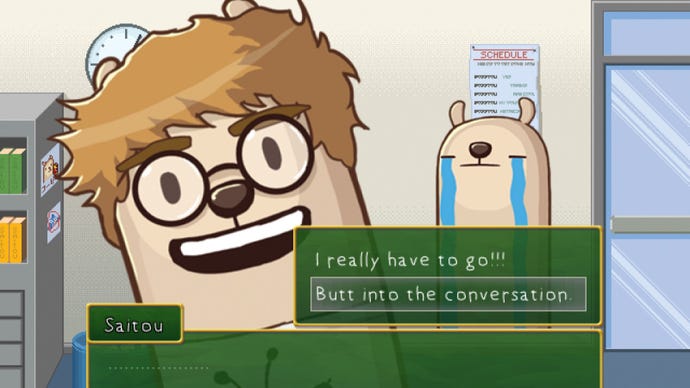
Ed: Mr. Saitou sees you play as an average white collar worker in Japan who's worked to the bone. After waking up in hospital, you meet a kid who - long story short - helps transport you to a world where you're a llama and a worm spliced together: a llamaworm. What ensues is a heartfelt pixel RPG about the absurdities of business, presenting the ruthlessness of Japanese working culture through a ridiculous lens because, yes, it deserves to be ridiculed.
The game only took me around three hours to complete, but it's one of very few games that have stuck with me so far this year (I also love a game that isn't, like, 40 hours long!). Expect some light puzzling and genuine laugh-out-loud moments that are actually funny, mixed in with some serious reflection that might loosen your tear ducts.
Resident Evil 4
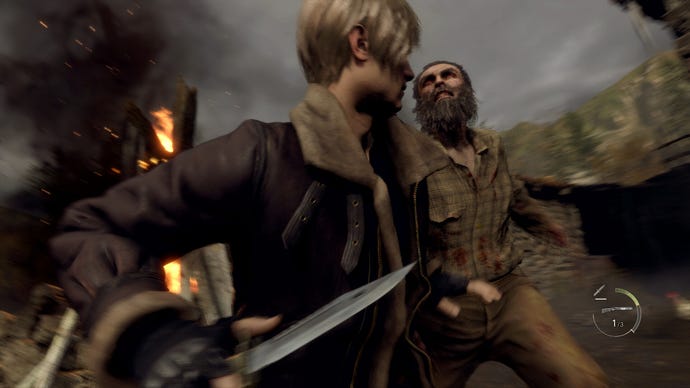
Liam: My favourite game of all time received a remake this year, and somehow it’s just as good as that original version. I should know, because since release I’ve finished it a further three times, something I haven’t done with any other game since I was a kid. The Resi 4 remake isn’t just a simple retread of the 2005 original. It’s a complete overhaul, carrying over ideas and quality of life improvements from recent entries in the series while remaining faithful to what made Leon’s Spanish holiday so beloved in the first place.
Combat is tighter. Enemies are more vicious. Characters have more depth and emotion. The story is more cohesive, yet no less dumb than before. This is Resident Evil at its best, an explosive eleven-hour jaunt through guts and gore and rubies and mud. Oh, and that original game? Still there. Still brilliant. You almost get the sense that Resi 4 remake had no intention of replacing it, choosing instead to offer an alternative take on an action classic. A wonderful, wonderful game.
Dredge
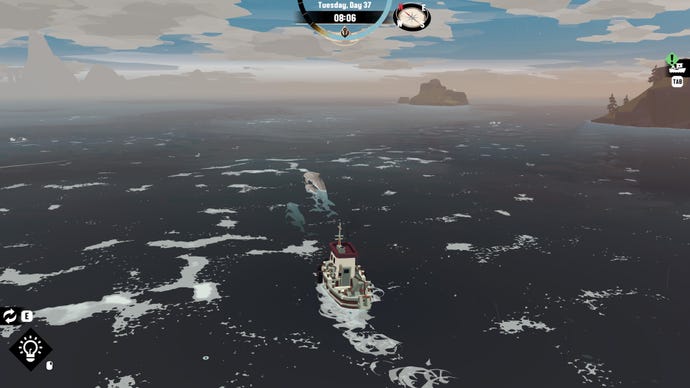
Hayden: Dredge is full of the sort of weirdos that would pop up in an episode of Scooby Doo. The mysterious collector in a decrepit mansion, eerily enquiring about sunken treasures. The withered lighthouse keeper with knowledge of things strange and otherwise unknown. The fishmonger who requests mutated aberrations that would absolutely kick-off a zombie apocalypse. And, of course, the spooky sea monsters that thrash about the rocks and lurk under the ocean, only revealing themselves as you grow increasingly mad in the dark, stormy night.
Trundling about on that ocean, you’re a small boat. A tiny lil dude, bobbing around in the water, revving your engines to reach the shore with the same fervour as a fly desperately buzzing away from magazines and other makeshift swatters. Each time you steam across the ocean, you prepare for a skin-of-your-teeth encounter with the denizens of the deep, and that makes every expedition a nerve-wracking adventure. Sure, you might leave with a plan. ‘I’ll be back by sun-down’, you think, ‘a simple adventure to make some cash!’ But the morish upgrade cycle relentlessly teases you with sunken wrecks and mysterious isles that undoubtedly hold precious goods, tempting you further from the havens that you call home and closer to the dangers that dwell in the dark.
Honkai: Star Rail

Rebecca: Despite having an admitted fondness for Genshin Impact, I wasn't sure HoYoverse were going to pull off a single-player turn-based RPG set on a space train, especially one still bewilderingly monetised using a gacha system. But Honkai: Star Rail gives you most of your canonical party members for free right at the start, meaning that you can elect to treat it like a traditional RPG with a limited pool of characters, and for me at least this actually adds to the fun. I'd much rather fight evil mechs and ersatz Stormtroopers alongside my ragtag Astral Express roommates than with some stat-rich demi-god I can't even remember meeting in the story, but maybe that's just me.
Just like with Genshin, the presentation of Star Rail is beautiful. The turn-based combat is also deeply satisfying, still incorporating HoYoverse's signature use of elemental powers despite the shift into harder sci-fi. It's just such good fun I struggle to put it down, and that addictiveness is entirely divorced from any compulsion to engage with its real-world gambling aspects. If Star Rail had been released with the same core concept but sans its money-hungry live-service model, it could quite possibly have ended up as my GOTY. As it stands, while dodgy monetisation certainly detracts from Honkai: Star Rail, it's a far cry from negating everything I've found to like about it.
Ollie: The exact moment I decided I’d reluctantly fallen in love with Honkai: Star Rail was when I first fought with Himeko and used her Ultimate ability. In one of the most fabulously animated and choreographed moves I’ve ever seen, where she sits on a chair and sips her coffee while simultaneously ordering a weaponized satellite in orbit above the planet to unleash a Godzilla atomic breath attack upon the opponents in front of her. It’s stupid, and spectacular, and a hundred hours later, it still makes me laugh.
That Which Gave Chase

Alice0: Mushing a dogsled through the arctic sounds difficult even on a good day. It's not any easier when you're ferrying a scientist as he attempts to return to a mysterious expedition, nor when the wildlife start behaving mighty strange. That Which Gave Chase is a first-person horror game lasting about an hour, a length I wish more horror games would be. Set on a mundane run, learn how to shift your body to keep the sled upright on rough terrain, chat with your passenger along the way, learn how to fire a gun, just in case, then slowly descend into uncertainty, dread, horror, and terror.
It strikes a good balance of mundane sledding (complete with the pleasing little procedure of manually dropping anchor to fully stop) and unpleasantness, and you can never quite tell what will come next, or what sort of horror game it will turn out to be. The plot advances with stylish and sometimes startling cuts between scenes. It's not always clear where, when, and maybe even who you are. Great retro look to it all too.
And if this matters to you (as science shows it does to many of you): yes, you can pet the dogs.
Tiny Life
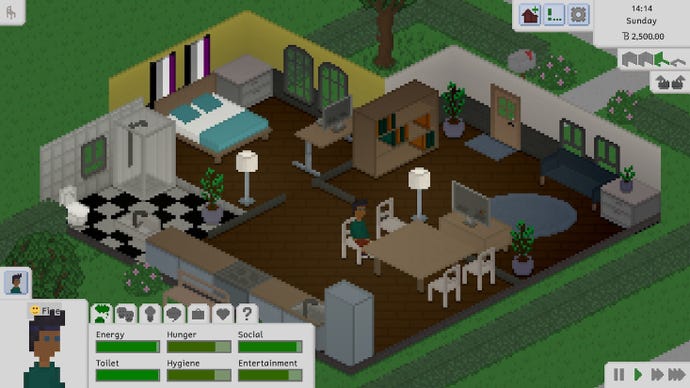
Rebecca: Some people will tell you that Tiny Life is a low-fi indie alternative to The Sims 4. I maintain that they're missing the point a bit, possibly because they don't realise that Tiny Life is actually a faithful pixel art recreation of 2000's original The Sims. Sure, Tiny Life contains many quality-of-life updates to account for 20-odd years of refinements within the life sim genre, but it's a hard-as-nails/needs-balancing challenge that fellow millennials will understand on a primal level.
Picture waking your little computer person up at 7am after they barely made it to bed without passing out after their night shift, so that they can eat a quick breakfast to prevent them from starving to death while they go back to sleep between now and lunchtime. Now picture your genuine feeling of satisfaction when it all falls into place: suddenly your Tinies aren't on the verge of death, the promotions are rolling in, and the household bank account is looking healthier every day. If you had a pleasant shiver at a childhood flashback just then, you just might be a fellow child of the '90s/'00s. And you will probably really like Tiny Life.
Veiled Experts
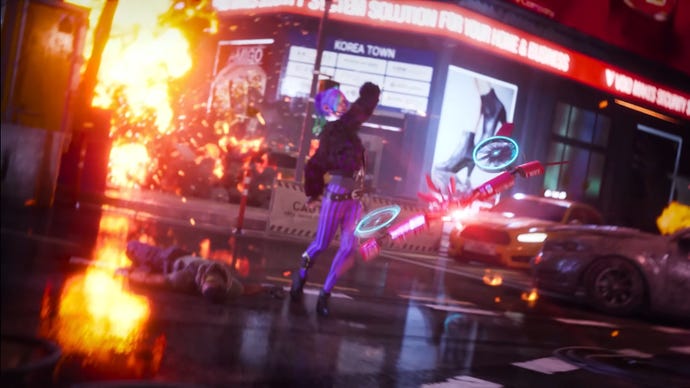
Ollie: Never have I been so surprised to find out that a game is actually really, really good. Veiled Experts is a third-person take on the Counter-Strike formula: team-based rounds of bomb planting and bomb defusal. Third-person should not work in this context at all, but it just... does. You can't just sit back and third-person-peek around a corner waiting for a good shot. Veiled Experts puts huge emphasis on keeping players moving throughout a round, both by having a battle royale-esque border that closes over time, and by equipping players with limited wall-hacks in the form of scan grenades and scan bows.
It's a bizarre jigsaw of ideas that you wouldn't expect to fit together so neatly, but they do. Aside from this, it's a startlingly polished and nice-feeling shooter. Maps are cleverly designed and look great, the different heroes are well balanced, the guns feel very impactful, and the animations (particularly when scaling building walls) are just wonderful. I went in expecting to hate Veiled Experts, and dozens of hours of matches later, it's a strong contender for my GOTY so far.
Halls Of Torment
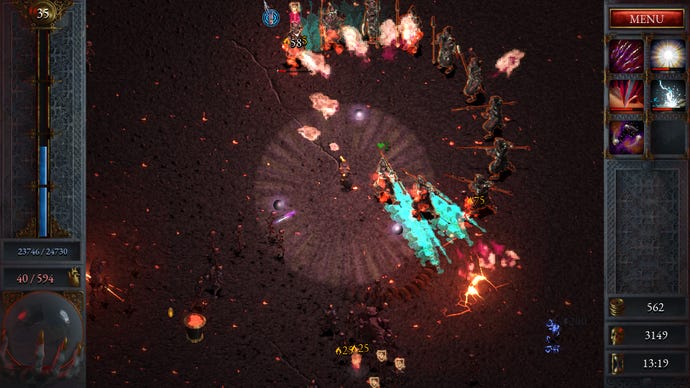
Alice0: 'Vampire Survivors meets Diablo' is your quick pitch for Halls Of Torment, a game where you try to survive 30 minutes of walking around bursting hordes of skeletons and demons so you can hoover up XP gems from their bones so you can level up so you can upgrade your stats and abilities so you can burst bigger, tougher hordes of skeletons and demons. It's fun! And it looks an awful lot like old Diablos, as well as borrowing familiar concepts from them - though not enough.
As I said before, I wish the Diablo influences spread deeper into loot. Bosses in Halls Of Torment sometimes drop items but it's not an exciting opportunity for rare and powerful new goodies, merely an additional step of busywork added over typical Survivors 'em up systems of unlocks and persistent progression. Hours of play later, the item drops still feel like a missed opportunity. That said, I am still playing hours later. Halls Of Torment is only one month into early access so I'm hoping the developers might yet rework loot. In the meantime, I have skeletons to click on.
The Tartarus Key
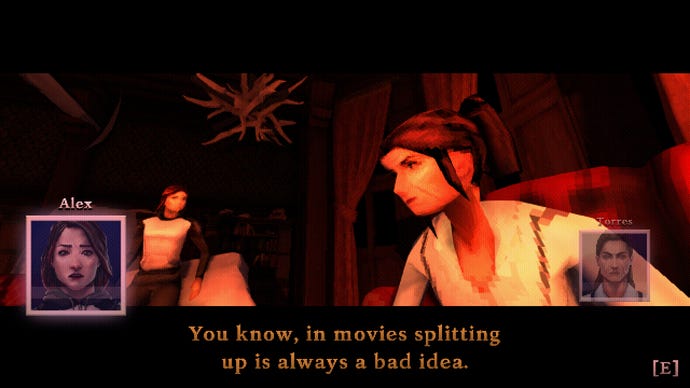
Alice Bee: I've been quietly banging the 'buy this game' drum about The Tartarus Key for a while now. It's a 00s-vibe puzzle game that challenges you to complete a series of increasingly bizarre locked room traps, in a bizarre, Saw-esque mansion. The 00s vibe comes not just from the low-poly, low-draw distance PS1-style graphics, but from the tone of the story. It's like a melange of 00s horror and thriller tropes: cloning, secret societies, poison, demons, and there's even amnesia thrown in there as well.
The sticking point for many people will be that the puzzles themselves vary from "ooh, that was a bit of a head-scratcher" to "I had to close the game for a couple of hours and come back to it", which can be a high barrier, especially if you're there for the vibes rather than the puzzles. Some of the more critical puzzles are to save a fellow kidnap victim, and if you fail they can end up dead, donezo, kaput – which in turn changes the ending you get. But I liked that, and I got an enormous sense of satisfaction from completing The Tartarus Key, and in fact found it very refreshing compared to a bunch of the deliberately frictionless mainstream fare. I've been forcing everyone to play it.
We Love Katamari Reroll + Royal Reverie

Liam: None of you are playing Katamari and it’s upsetting me. What’s wrong? Do you hate joy? Are you averse to smiling? Do you wake up every morning and think, “Ah yes, I have enough serotonin already thank you very much”. Liar! You fear happiness because you believe it is fleeting! Katamari offers an alternative to your theory: happiness can be contained! Happiness can be bottled! The rolling of the Katamari is a joyous act! Praise the prince! Praise the king! Praise the stupidly named, but no less joyous, We Love Katamari REROLL+ Royal Reverie!
Diablo 4
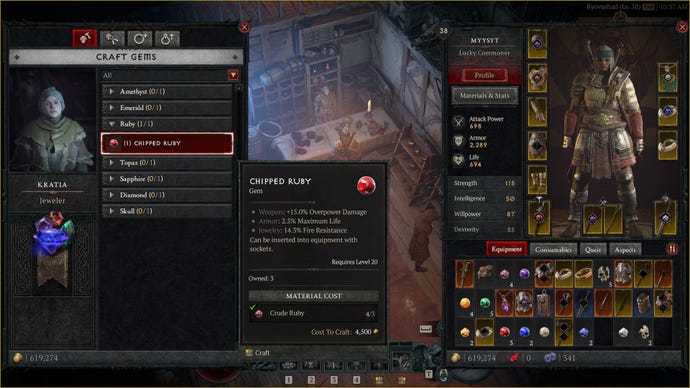
Hayden: I have icky feelings about Diablo 4. On the one hand, it demands my time for a grind that rarely feels impactful, chucking Legendaries and Uniques at me with random stat rolls that aren't exciting to chase. The classes are limited in their build variety, with a few standout options and little room to experiment outside of the predetermined archetypes There are countless gripes, and no room to discuss them here.
And yet! I can’t stop playing. Diablo 4 has sunk its claws in deep, and I return every night for more delectable demon-smacking. I delve into Nightmare Dungeons, and cheer when I get a drop that does matter for my build, rare so it may be. When my build pops off and I melt packs of enemies with a chain-reaction of shadow explosions, it feels amazing. The best part is that my friends are all there with me, too. We log on daily, having chats about patch notes that are the most boring thing on earth as we feverishly run to world bosses like a pack of rabid animals, desperate for our kibble. It’s been a while since a game has rallied us together in this way, and, despite the many issues, that’s quite lovely.
